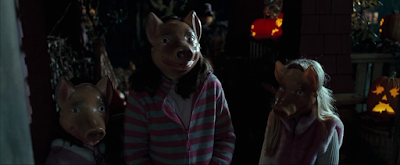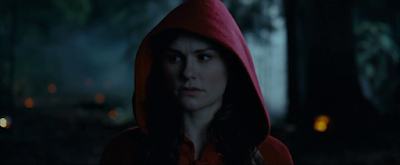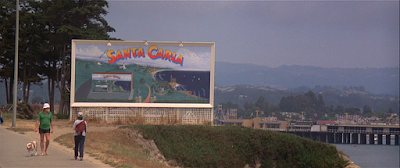
During a month I'm basing around "bad" movies I personally enjoy, it seems fair to talk about at least one property that I find to be genuinely bad and not very enjoyable and, unfortunately it had to be Ratched.
When Ratched was announced, I was es-fuckin'-static: One Flew Over The Cuckoo's Nest is one of my personal favorite movies and a show that would give the antagonist of said film, Nurse Ratched, the treatment Bates Motel and Hannibal gave to Norman Bates and Hannibal Lecter respectively? I was on board with that and, while a lot of people really hate the guy, I didn't mind that it was Ryan Murphy bringing Ratched to life, as he's responsible for the wonderful and cancelled too soon horror comedy Scream Queens (Read some more of my love of it here) and, while I find it aggressively hit or miss, when American Horror Story is good, it's really good. Murphy's muse, Sarah Paulson, was announced as portraying the titular role, which was a third bit I was excited for. Paulson rarely gets to play villainous roles, even on AHS, so the chance for her to sink her teeth into a wicked role had me giddy. Really, I thought the show had nowhere to go but up.
Well, unfortunately while watching the final product on Netflix, I had one recurring thought throughout the entire season: Where did this all go wrong?

For starters, it feels like Murphy and the crew didn't even watch the original film or read its source material while making this show. Gone is the raw dramatic feel of Milos Forman's direction and Ken Kesey's writing, instead replaced with a bright, manic and extremely colorful tone. While that usually works for Murphy's other series, it is a jarring choice for a source material that was more or less rooted in reality. As a result, the series suffers as instead of going for the rousing touch needed for this material, we are instead treated to increasing wackiness that includes a revenge plot centered around a self-amputated boy that goes nowhere, multiple characters whom have no reason to exist beyond being plot devices to move certain characters around to their respective destinations and a season ending that manages to rip off both Brian De Palma's Dressed To Kill and Jonathan Demme's film adaptation of The Silence of the Lambs. Many critics of Murphy's shows often criticize his works as consisting of excessive amounts of characters, meaningless plotlines and random moments thrown in to inspire viral gifs. Ratched, unfortunately, falls fully victim to these lackluster impulses.
Speaking of excessive characters, let's take a moment to talk about Ratched's stacked cast. Besides Paulson, the ensemble also includes her fellow AHS alumni Finn Wittrock and Jon Jon Briones, as well as Cynthia Nixon, Judy Davis, Charlie Carver and Sharon Stone. Sadly, as I mentioned, most of these performers are wasted in their roles. Wittrock's character lacks any substance beyond just being motivation for Ratched's character to be in the hospital, while Briones's Dr. Hanover amounts to mainly being a patriarchal obstacle for Ratched to manipulate and overcome. Nixon's character serves as Ratched's love interest, but lacks any intrigue that really makes you want to root for the two to be together. I don't even know why Carver and especially Stone were even cast, as their characters ultimately have no purpose and exist...for the sake of adding more melodrama, I suppose? I honestly don't know what made them want to sign on, besides wanting to work with Murphy.

There is one character that manages to almost save the show for me: Betsy Bucket, played by Judy Davis. While Bucket's initial purpose is be an antagonist for Ratched on the same level as her, with the two of them both being nurses, she manages to transform from a cranky foil with an unrequited crush on Dr. Hanover to an empowered ally of Ratched's who takes her former love's place as the head of the hospital. Bucket is the only character in the series who gets a consistent arc and it not only allows Davis to shine, but for her to steal every scene she's in. Including a very memorable one in which Bucket and Ratched feud over the former taking the latter's peach to eat. Not only do Davis and Paulson display superb chemistry and have a dynamic that allows for Paulson to really channel the source material, but Davis, in particular, delivers her dialogue in an almost Tarantino-esque fashion that allows for the humorous scene to feel more organic than other comedic bits throughout the season.
You might have noticed I haven't addressed Paulson yet, which is because that leads into what I believe went wrong with this series. I think the reason behind my disappointment with Ratched can be traced to Murphy wanting to pay tribute to filmmaker Brian De Palma. Not only does Murphy homage some of De Palma's famous filmmaking techniques, including hefty uses of color and split screens, but he also borrows heavily from other works. Many have noted that De Palma often borrowed from other works for his own and, while a lot of the works he borrows from are usually the films of Alfred Hitchcock, he has also been documented as borrowing from himself, such as recycling the twist ending from Carrie for the conclusion of Dressed to Kill. Murphy takes De Palma's dabbling in cannibalization and turns it up to eleven, with many parts of Ratched being recycled from Murphy's previous works. While Paulson's acting is fine, the character she is given is, more or less, a more manipulative and less openly queer version of her Lana Winters character from AHS's second season. There are other examples as well: Stone's Lenore Osgood and Brandon Flynn as Lenore's son Henry are basically the characters played by Wittrock and Frances Conroy in AHS's fourth season, while Briones's Dr. Hanover is a combination of Matt Ross and Joseph Fiennes's roles from AHS's first two seasons. Plotlines and ideas are also recycled from other works, such as Hollywood (The historical alterations and focus on minorities) and Scream Queens (the attempts at comedic hospital hijinks) among others.
When it comes down to it, if you want to see Murphy tackle Cuckoo's Nest in a well-done manner, check out season 2 of AHS, subtitled Asylum, as there are several homages to the film that ring truer than this attempt at adaptation. Otherwise, unless you're in it for Judy Davis like I am at this point, leave Ratched on the chopping block.

































































